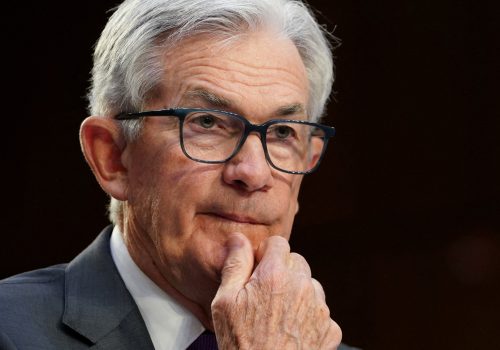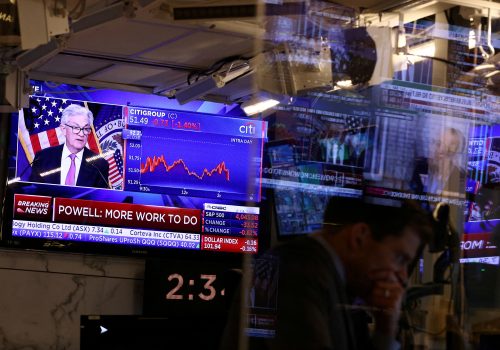The Federal Reserve’s dilemma: Choosing between monetary policy and financial stability
On Sunday, March 19, central banks representing the world’s leading reserve currencies announced a coordinated set of initiatives to increase US dollar liquidity in the financial system. Their stated purpose is to ease liquidity constraints that adversely impact “the supply of credit to households and businesses.” The central banks, in announcing the initiatives, did not mention Credit Suisse, Republic Bank, Signature Bank, or Silicon Valley Bank. The move comes just days before the Federal Reserve’s next regularly scheduled monetary-policy meeting.
The monetary-policy challenge cannot be overestimated.
Monetary policy basics
The Fed has a famous dual mandate that requires it to set interest rates that optimize price stability and full employment simultaneously over the medium term. In the most recent semi-annual monetary policy testimony to Congress on March 8, Federal Reserve Chairman Jerome Powell characterized the mandate as pursuing “our maximum-employment and price-stability goals.”
But the Fed has two additional mandates that overlap with monetary policy at the margins: financial stability and managing payment-system access/operational integrity. During crisis situations, these additional mandates deliver the deciding factor for interest-rate policy.
The Fed is now in an unenviable position. Its monetary-policy and financial-stability mandates are at odds with each other. Raising interest rates would be justified—based on underlying economic theory pertaining to prevailing inflation rates and labor market strength—but doing so will generate additional stress on bank liquidity buffers. On the other hand, pausing or cutting rates will at least tacitly acknowledge that monetary policy intensified (if it did not cause) the current financial system stresses.
The systemic stresses in play today are rooted in two specific details from the financial crisis in 2008.
The Global Financial Crisis and the high-quality liquid assets problem
One of the many Basel III reforms (enshrined into US law via the 2010 Dodd-Frank Wall Street Reform and Consumer Protection Act) involved creating a sensible requirement that banks hold more liquid assets. Banks were required to hold high-quality liquid assets (HQLA) so that they could meet liquidity needs by relying on capital markets rather than on possible government bailouts. The securities that most easily meet the definition of HQLA are US government bonds.
Many policymakers solemnly vowed at the time that they would never again bail out a bank. Whether bailing out billionaire depositors (with deposits in excess of $250,000) is morally superior to bailing out bank shareholders should be debated separately. The bigger point is that this was not supposed to happen again.
There’s an HQLA problem—one that extends well past Silicon Valley Bank. The assets that banks hold may still be high quality, but the price and value of those assets have eroded significantly in the last year as interest rates increased. In addition, efforts to liquidate those securities at scale create other problems. Significant drops in price could potentially trigger risk limits at other banks, requiring them also to liquidate US Treasury bonds at fire sale rates.
A race to liquidate HQLA amid increasing interest rates while the Fed chases “maximum employment” would create much larger, undesirable financial system stresses. In other words, the run on Silicon Valley Bank at the start of March is actually the benign scenario. A sizable hole exists in bank balance sheets due to the erosion in value amid high and rising rates. The Federal Deposit Insurance Corporation’s data from the end of last year paints a somber picture:
The newly launched Bank Term Funding Program (BTFP) thus understandably tells banks not to sell their Treasury securities. Instead, the Fed promises to deliver to the banks liquidity support at par value (not the much-lower market value) against collateral in the form of… Treasury securities. The framework thus helps stabilize market prices for those instruments by suppressing sales.
Markets remain in a precarious position, as the coordinated central bank dollar-liquidity lines indicate. Many in finance will not be surprised. Within the first few days of operation last week, Reuters reports, banks utilized nearly half of the BTFP ($11.9 billion out of the available $25 billion)—and they had acquired additional liquidity support through the Fed’s discount window facility at a historic level.
This is the first time this century that the discount window has been tapped at scale without a recession also being present. Treasury markets also came under stress last week.
The United States approaches this period of financial uncertainty with a booming economy and a booming labor market. However, data showing continued strength regarding inflation, the labor market, and gross-domestic-product growth all require a data-dependent Federal Reserve to continue hiking interest rates. More interest rate hikes will further erode the value of HQLA on bank balance sheets globally.
The Fed seems to have boxed itself into a corner, creating cross-border financial instability that tarnishes US leadership. From Europe to Japan, economies were emerging from the pandemic with a soft landing in their sights. If the HQLA situation triggers further instability and damages the global recovery, many policymakers may begin to question US economic leadership.
Barbara C. Matthews is a nonresident senior fellow at the Atlantic Council’s GeoEconomics Center. While in government, she served first as senior counsel to the House Financial Services Committee and then as the Treasury Department’s first attaché to the European Union. She is currently the founder and chief executive officer of BCMstrategy, Inc.

At the intersection of economics, finance, and foreign policy, the GeoEconomics Center is a translation hub with the goal of helping shape a better global economic future.
Further reading
Mon, Mar 20, 2023
Central bankers must keep financial stability in mind as they fight inflation
New Atlanticist By Hung Tran
It is difficult for central banks to balance controlling inflation with preserving financial stability amid a banking crisis, but that is no excuse not to try.
Thu, Mar 16, 2023
It’s not 2008: Keep calm as central banks carry on
New Atlanticist By Josh Lipsky
This week's financial drama may look familiar, but the world's financial firefighters have been preparing for this moment for nearly fifteen years.
Wed, Mar 15, 2023
Bailouts create a moral hazard even if they are justified. Is there another way?
New Atlanticist By Hung Tran
The US guarantee for Silicon Valley Bank and possible Swiss intervention for Credit Suisse raise important questions. Here's one alternative approach for large depositors.
Image: Federal Reserve - Central Banking


